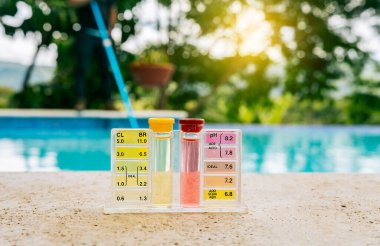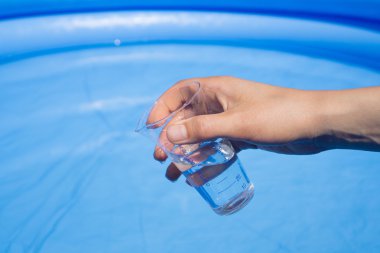- Home
- Natural Cleaning Agents
- Too Much Muriatic Acid in Pool
What Happens if You Put Too Much Muriatic Acid in Pool: A Comprehensive Guide
If you accidentally add too much muriatic acid to your pool, it can lead to several problems. The chemical composition of your pool's water will change, making it unsafe for swimming. Pool equipment may also suffer from corrosion. Understanding how to detect and correct the overuse of muriatic acid is essential for maintaining a safe and enjoyable swimming environment.
Adding too much muriatic acid can lower the pH and total alkalinity significantly, which might harm your pool's surfaces and pool equipment. It's important to know the right amount of chemicals to add to your pool chemistry toolkit. In case you put too much muriatic acid, using sodium carbonate or soda ash can help neutralize the acidity. Following a step-by-step guide will be crucial to restoring your pool's balance.
Introduction to Muriatic Acid's Role in Pool Maintenance

Muriatic acid plays a critical role in pool maintenance by keeping the water clean and preventing ineffective chlorine from harming the pool's ecosystem.
Understanding the Function of Muriatic Acid
Muriatic acid is essential for adjusting the pH and total alkalinity in swimming pools, ensuring the water remains clear and safe.
Lowers Total Alkalinity and pH Balance
When you add muriatic acid to your pool, it reduces the total alkalinity and pH balance, making the water more acidic. This is necessary to maintain a healthy swimming environment. Always wear safety gear like acid-resistant gloves, safety goggles, a chemical-resistant apron, and use a plastic stirrer when handling muriatic acid or any pool chemicals. Dry acid is milder than muriatic acid but requires similar precautions.
Cleans Cartridge Filters and D Grids
Muriatic acid is also used for cleaning cartridge filters and D grids in your pool's filtration system. It helps remove accumulated dirt and debris, ensuring the pool water remains clean and clear.
Stain Removal from Concrete Pool Surfaces
As a powerful stain remover, muriatic acid can get rust stains off of your pool’s surfaces and pool deck, restoring their appearance.
The Risks of Overusing Muriatic Acid

Overusing muriatic acid can disrupt the balance of your pool, leading to altered pH and alkalinity levels that can damage pool equipment and harm swimmers.
1. Altered pH and Alkalinity Levels
When too much muriatic acid is added, the pH and alkalinity levels can drop below the recommended parts per million, disrupting the balance of your pool and potentially causing damage to pool equipment.
2. Potential Health Risks to Swimmers
Swimmers may experience skin irritation and eye problems if they swim in a pool with a chemical imbalance caused by too much muriatic acid.
3. Corrosion of Pool Equipment
Excessive muriatic acid can corrode pool equipment, leading to expensive repairs or replacements.
Detecting Overuse of Muriatic Acid in Your Pool
If you've added too much muriatic acid, your pool's pH will drop significantly, and you might notice damage to your pool pump and other equipment.
Signs You've Added Too Much Muriatic Acid
Signs that you've added too much muriatic acid include a sudden drop in pool pH.
Testing Water Chemistry
To ensure safe and enjoyable swimming, regularly test your pool's water chemistry with appropriate pool equipment.
Observing Visible Damage and Irritations
If swimmers experience skin irritation or eye discomfort within 30 minutes of swimming, it may indicate too much muriatic acid has been added.
Corrective Measures for Excessive Muriatic Acid Application
To correct the effects of excessive muriatic acid, you'll need to carefully neutralize the acid levels and restore your pool's chemical balance.
Step 1: Testing the Water and Preparing Necessary Tools
Before you start fixing the problem, you need to know exactly what you're dealing with. Grab a water testing kit to check the water’s pH. You’re aiming for a pH level between 7.2 and 7.6. Also, gather your tools like protective gloves, goggles, and sodium bicarbonate, which you’ll use to correct the pH level. This step is crucial for ensuring you handle the issue safely and effectively.
Step 2: Balancing the Water with Sodium Bicarbonate
If the pH is too low, it’s time to bring it back up to the desired range. Slowly add sodium bicarbonate to the pool, following the manufacturer's instructions for the correct amount based on your pool's volume. Sodium bicarbonate raises the pH level without drastically altering the water’s total alkalinity. This step is gentle but effective, making it a safe choice for pH adjustment.
Step 3: Circulation and Dilution
After adding sodium bicarbonate, turn on the pool pump to circulate the water. This helps distribute the sodium bicarbonate evenly throughout the pool. If the pH is still too low, you can add more sodium bicarbonate, but always retest the water before adding more. Sometimes, simply adding fresh water with a garden hose can also help dilute the acidity and bring the pH level closer to the desired range.
Step 4: Additional Water Adjustment Steps
If the pH level is stubbornly low even after you've added sodium bicarbonate, retest the water and consider adding a pH increaser specifically designed for pool use. Follow the instructions carefully, as adding too much can swing the pH too high. Remember, adjusting pool chemistry is a bit like baking a cake - it requires precision and patience. Use a garden hose to add fresh water if needed, to help balance the pool chemistry.
Step 5: Continuous Monitoring
Finally, keep a close eye on your pool's pH level by testing the water regularly. Pool chemistry can change quickly, especially after heavy use or a rainstorm. By staying on top of the water conditions, you can avoid the need for major chemical adjustments in the future. Remember, prevention is better than cure, so regular monitoring is your best defense against pH imbalances.
What happens if you put too much muriatic acid in pool?
Effects of Too Much Muriatic Acid
Adding too much muriatic acid to a swimming pool can have several negative effects:
- It lowers the pH and alkalinity levels of the water to unsafe levels below the recommended ranges of 7.2-7.6 for pH and 80-120 ppm for alkalinity.1 This makes the water too acidic.
- Highly acidic pool water can cause skin and eye irritation, respiratory issues like coughing and difficulty breathing, and even chemical burns for swimmers.12
- The corrosive muriatic acid can damage pool surfaces, tiles, and equipment like ladders, pumps and filters.1 Metal parts are especially susceptible to deterioration.
- Chlorine becomes less effective at sanitizing the water when pH is too low, allowing bacteria and algae to grow.
Signs You've Added Too Much Acid
Some indications you may have added too much muriatic acid include:
- pH and alkalinity test results far below normal ranges
- Strong, pungent odors around the pool from acid fumes
- Corrosion or etching of pool surfaces and equipment
Safe Use of Muriatic Acid for Pool Care
When used correctly, muriatic acid is a powerful tool for keeping your pool clean and balanced. But it's strong stuff, so handle it with care.
1. Proper Dosage and Application Techniques
Getting the right amount of muriatic acid is key to pool care without risks. Too little won't make a difference, but too much can cause problems..
Calculating the Correct Amount of Muriatic Acid
To figure out how much muriatic acid to add to your pool, start by testing the water’s pH. The amount you'll need depends on the current pH level and the volume of your pool. There are charts and online calculators that can help you get the numbers right. Always aim for a pH level between 7.2 and 7.6 to keep your pool water balanced and safe.
Safe Methods to Add Muriatic Acid to Your Pool
When it's time to add muriatic acid to your pool, never pour it all in one spot. Instead, dilute it in a bucket of water and spread it around the pool’s perimeter. This method helps prevent damage to your pool's surfaces and ensures the acid mixes evenly with the pool water. Always add acid to water, not the other way around, to avoid dangerous chemical reactions.
The Importance of Water Circulation Post-application
Right after adding muriatic acid, turn on your pool’s pump to circulate the water. This helps spread the acid evenly, preventing spots of high acidity which can damage the pool or harm swimmers. Circulating the water also helps the acid work more effectively in balancing the pool’s pH.
Frequently Asked Questions About Muriatic Acid
Got questions about muriatic acid? You're not alone. Here are some common queries.
1. How Long Does It Take for Muriatic Acid to Adjust Alkalinity?
After adding muriatic acid, it can take a few hours to a day for the alkalinity levels to fully adjust. It's best to test the water after about 4 to 6 hours to see if you've reached the desired pH level. Sometimes, it may require a bit more time or an additional adjustment to get it just right.
2. Differences Between Muriatic Acid and Other Pool Chemicals
Muriatic acid is a strong acid used to lower the pH and alkalinity in pool water, making it unique compared to other pool chemicals. While other products might also adjust pH, muriatic acid is often chosen for its effectiveness and cost-efficiency. However, it requires careful handling due to its corrosive nature.
3. Direct Application of Muriatic Acid to Pool Water
Directly adding muriatic acid to your pool should be done with caution. Always dilute the acid in water before adding it to the pool, and ensure the pool pump is running to distribute the acid evenly. This approach helps avoid damage to the pool and ensures a safer swimming environment.
4. Ideal Muriatic Acid Quantities for Pool Treatment
Getting the amount of muriatic acid right for your pool is crucial. Usually, you'll add about 1/4 gallon (or 946 ml) of muriatic acid for every 10,000 gallons of pool water to decrease the pH by about 0.1. However, these numbers can vary based on your pool's current pH and alkalinity levels.
It's always a good idea to start with less, as you can always add more if needed. Remember, wearing protective gear and ensuring proper water circulation post-application are key steps to success.
5. Timelines for Safe Swimming After Muriatic Acid Addition
After adding muriatic acid to your pool, it's important to wait before diving back in. A good rule of thumb is to allow at least 30 minutes for every gallon of acid added, with a minimum wait time of 4 hours. However, the best practice is to test the water's pH level to ensure it's back within a safe range (7.2 to 7.8) before swimming. Keeping the pump running during this period helps distribute the acid evenly and speeds up the process.
Alternatives to Muriatic Acid in Pool Maintenance

While muriatic acid is effective for balancing your pool’s pH and alkalinity levels, alternatives like sodium bisulfate (dry acid) offer a less hazardous option. These alternatives can be just as effective in maintaining a well-balanced pool without the risks of handling muriatic acid. However, it’s important to address issues like algae blooms and calcium buildup proactively, regardless of the chemicals used. Always follow the manufacturer’s guidelines when adding any chemicals to ensure your pool remains a safe and enjoyable environment.
1. Exploring Other pH Balancing Options
Apart from muriatic acid, pool chemicals like sodium bisulfate (dry acid) and sodium carbonate (soda ash) are popular for adjusting pH levels. These alternatives to muriatic acid are safer to handle and can be easier on your pool environment. If you accidentally add too much muriatic acid, these options can help correct the pH balance. Always consult a pool professional or follow the manufacturer’s instructions to maintain proper pool chemistry.
Benefits and Drawbacks Compared to Muriatic Acid
While muriatic acid effectively lowers your pool’s alkalinity and removes stains, it can be hazardous to handle, potentially causing severe burns. Alternatives like sodium bisulfate are safer to handle but may not be as effective in certain situations, such as heavy stain removal from concrete and brick. Choosing the right chemical depends on your specific needs and comfort level with handling potentially dangerous substances. Safety and effectiveness should guide your decision in pool maintenance.
Conclusion: Navigating the Challenges of Muriatic Acid Use in Pools
Using muriatic acid in pool maintenance comes with challenges, including ensuring proper safety when handling this powerful chemical. Its ability to quickly adjust pH levels and alkalinity makes it a valuable tool, but also one that requires cautious handling. Wearing protective gear and understanding the correct amounts to use are essential for lowering your pool’s alkalinity without risking damage to your pool surfaces or harm to swimmers. Embracing a responsible approach to muriatic acid use is key to maintaining a safe and sparkling pool.
Emphasizing the Importance of Accurate Measurement and Cautious Handling
Accurate measurement and cautious handling are non-negotiable when it comes to adding muriatic acid to your pool. Whether you're managing a saltwater pool or a traditional chlorine pool, maintaining balanced pool water chemistry is crucial for a safe swimming environment. Always use a reliable testing kit to determine the exact needs of your pool before proceeding with any chemical adjustments.
Continuous Education and Monitoring as Key to Successful Pool Maintenance
Staying informed and vigilant is essential for successful pool maintenance. Regularly educating yourself on the latest pool care techniques and closely monitoring your pool’s chemistry can prevent issues before they arise. Whether it's adjusting pH levels with muriatic acid or exploring alternative chemicals, understanding the impact of your actions ensures a well-balanced pool. Remember, a proactive approach to pool maintenance not only extends the life of your pool but also enhances the safety and enjoyment of all who dive in.
You may also want to know if you can put muriatic acid down the drain